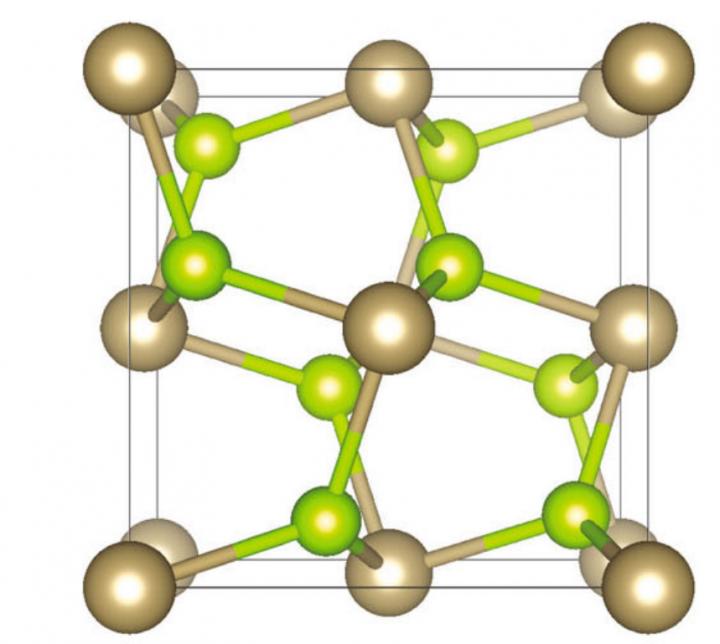New spin directions in pyrite an encouraging sign for future spintronics

This is the crystal structure of Pyrite OsSe2/OsTe2. Credit: FLEET Usage Restrictions: Only for use with this story
A Monash University study revealing new spin textures in pyrite could unlock these materials' potential in future spintronics devices.
The study of pyrite-type materials provides new insights and opportunities for selective spin control in topological spintronics devices.
Seeking new spin in topological materials
Topological materials have exciting potential for next-generation, ultra-low energy electronics, including thermoelectric and spintronic devices.
However, a restriction on the use of such materials in spintronics has been that all topological materials studied thus far have spin states that lie parallel to the plane of the material, while many/most/all practical spintronic devices would require out-of-plane spin states.
Generating and manipulating out-of-plane spins without applying an external electric or magnetic field has been a key challenge in spintronics.
The new Monash Engineering study demonstrates for the first time that pyrite-type crystals can host unconventional energy- and direction-dependent spin textures on the surface, with both in-plane and out-of-plane spin components, in sharp contrast to spin textures in conventional topological materials.
“A number of pyrite-type materials have previously been theoretically predicted to show the desired out-of-plan spin textures,” explains lead author Dr Yuefeng Yin, in Monash Engineering's Computational Materials Lab.
Pyrite (colloquially known as 'fool's gold') is an iron-sulfide mineral that displays multiple internal planes of electronic symmetry.
“The presence of strong local symmetry protects out-of-plan spin states,” explains Yuefeng, “so we decided to look closer at some of these crystals.”
The unconventional spin texture discovered opens new possibilities for the necessary task of injecting or detecting out-of-plane spin component in future topological spintronic devices.
THE STUDY
Selective control of surface spin current in topological pyrite-type OsX2 (X?=?Se, Te) crystals was published in NPJ Quantum Materials in August 2019 (DOI 10.1038/s41535-019-0186-8).
Using first-principles calculations, the Monash team separated surface spin states by their interactions with spin states in the bulk of the material, resulting in highly anisotropic but tunable behaviour.
As well as funding from the Australian Research Council (Centre of Excellence and ARC Laureates funding) the authors gratefully acknowledge computational support from the Monash Campus Cluster, NCI computational facility and Pawsey Supercomputing Facility.
THE LINK BETWEEN SYMMETRY AND TOPOLOGICAL MATERIALS
The presence of strong, local symmetry provides topological robustness to spin states, and symmetry is therefore a strong predictor of topological behaviour, so that studying these phenomena in pyrite crystals should provide clues towards discovery of many other new topological materials.
Topological insulators are novel materials that behave as electrical insulators in their interior, but can carry a current along their edges. Unlike a conventional electrical path, such topological edge paths can carry electrical current with near-zero dissipation of energy, meaning that topological transistors can switch without burning energy. Topological materials are investigated within FLEET's Research theme 1, seeking ultra-low resistance electronic paths with which to create a new generation of ultra-low energy electronics.
###
FLEET is an Australian Research Council-funded research centre bringing together over a hundred Australian and international experts to develop a new generation of ultra-low energy electronics.
MORE INFORMATION
* Contact lead author Dr Yuefeng Yin Yuefeng.Yin@monash.edu
* Contact group leader A/Prof Nikhil Medhekar Nikhil.Medhekar@monash.edu
* Follow FLEET at @FLEETCentre
* Visit FLEET.org.au
Media Contact
All latest news from the category: Materials Sciences
Materials management deals with the research, development, manufacturing and processing of raw and industrial materials. Key aspects here are biological and medical issues, which play an increasingly important role in this field.
innovations-report offers in-depth articles related to the development and application of materials and the structure and properties of new materials.
Newest articles

First-of-its-kind study uses remote sensing to monitor plastic debris in rivers and lakes
Remote sensing creates a cost-effective solution to monitoring plastic pollution. A first-of-its-kind study from researchers at the University of Minnesota Twin Cities shows how remote sensing can help monitor and…

Laser-based artificial neuron mimics nerve cell functions at lightning speed
With a processing speed a billion times faster than nature, chip-based laser neuron could help advance AI tasks such as pattern recognition and sequence prediction. Researchers have developed a laser-based…

Optimising the processing of plastic waste
Just one look in the yellow bin reveals a colourful jumble of different types of plastic. However, the purer and more uniform plastic waste is, the easier it is to…



